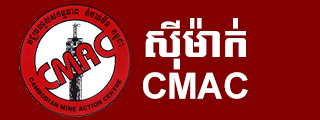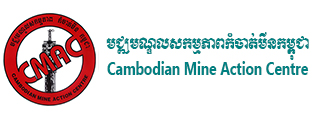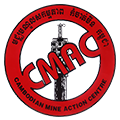A BRIEF- CMAC HISTORY
The Cambodian Mine Action Centre (CMAC) is Cambodia’s leading demining organization, working in the key areas of Survey and Land Release, Mine and UXO Clearance, Mine and UXO Risk Education and Training, Research and Development. CMAC currently has 1,715 staff across Cambodia, including a national office in Phnom Penh, six provincial demining units and a Training Centre in Kampong Chhnang, working towards the mission of “Saving lives and Supporting Development for Cambodia“.
CMAC was established during the United Nations Transitional Authority in Cambodia (UNTAC) in 1992, in order to assist the safe return of thousands of refugees to their homelands across the country. Recognizing that the large number of landmines and UXO across Cambodia was a significant threat to post conflict reconstruction and continuing development, CMAC became an autonomous national organization in 2000 and developed a series of programs including landmine awareness, landmine field information, landmine and UXO clearance and training in landmine clearance to achieve the safe transition to peace and security for the people of Cambodia.
Name: Cambodian Mine Action Centre (CMAC)
Established: 1992
Headquarters: Phnom Penh
Training Centre: Kampong Chhnang
Central Workshop: Battambang
Demining Units:Banteay Meanchey; Battambang; Siem Reap (including Kampong Thom including Oddar Meanchey& Preah Vihear), Kampong Cham (including Kratie, Prey Veng, Svay Rieng Rattanakiri and Mondulkiri).
Number of staff: 1,715
Number of field staff: 1,387
Number of female staff: 113
CMAC GOVERNING COUNCIL
The role of the Governing Council is to oversee the activities of CMAC and to give directions to ensure conformity with government mandates. It is also responsible for the approval of CMAC budgets, work plans, programs, accounts, and reports. As the tasking, external quality assurance, advocacy, and other national-level responsibilities will now fall with CMAA, the Governing Council oversight is focused on CMAC budget, structure and internal policies approval that will have to conform to any national policies and standards set by the CMAA
CMAC EXECUTIVE UNIT
CMAC Executive Unit is the core body which is responsible for demining activities. This body consists of a Director General, Deputy Director General and three departments: Department of Planning and Operations, Department of Support and Human Resources, and Department of Finance. The focus to date for CMAC has been on safety, effectiveness and efficiency. CMAC still needs to develop sound management capacity for its field operations to further enhance the issue of productivity.
CMAC MISSION STATEMENT
Saving Lives and Supporting Development for Cambodia
CORE VALUES
1. Safety
2. Cost Effectiveness
3. Honesty and Integrity
4. Appropriate Technology and Expertise
CORE ACTIVITIES
1. Landmine/UXO Clearance
2. Landmines Information, Survey and Marking
3. Landmine/UXO Risk Education and Reduction
4. Training, Research and Development in Mine Action
COMMITMENTS
As a National Humanitarian Mine Action Service Provider, we are committed to:
- Understanding and meeting the needs of the Cambodian people.
- Understanding and meeting the needs of the donors, partners and all key stakeholders, who assist and cooperate with us to fulfill CMAC mission.
- Understanding and meeting our obligations as a responsible employer by:
- Selecting the right people using fair and transparent process.
- Providing a safe working environment.
- Providing training and development opportunities for our staff.
- Providing appropriate equipment tools and materials for our staff to function effectively.
- Conforming to an impartial and moral code of conduct.
- Providing fair and equitable salaries and benefits to our staff.
- Creating active linkages with mine action partners and development agencies in Cambodia and with mine action agencies internationally.
- Developing and maintaining sound policies, procedures and work practices.
- Measuring and publicizing our performance in all activities and using these measurements as the basis for continuous improvement.
LANDMIN/UXO HISTORY
The Mine Contamination Map l The UXO targets Map
Geographically, Cambodia is located in the South-East Region of Asia on the Gulf of Thailand. Cambodia’s neighboring countries include Thailand to the South-West, Vietnam to the East, and Laos to the North. The total area of Cambodia is 181,035 square kilometers. Much of the land is forested, mountainous, and inaccessible due to poor infrastructure and landmines. The history of Cambodia is very closely attached to the history of the whole region, which is associated with many years of political unrest, tension, colonial and civil wars, and international border conflicts from time to time.
As a consequence of these geo-political movements, Cambodia was engaged in many decades of wars, resulting in loss of millions of lives, severe and extensive damages to the economy and national infrastructure, and above all else, the eternal threats by long term enemies to human lives and development – the land mines and other unexploded ordnances, scattered everywhere throughout the country. Cambodia’s unrest started with the World War II, when Cambodia became a victim of international conflicts. Bombs were dropped, hand grenades were thrown, and bullets were fired.
Exploded ordnances became fragments scattered everywhere. Unexploded ordnances remained untouched and hidden, ready to explode. When World War II had finished, the French Indochina Wars came as a replacement during the 1950’s. More bombs were dropped, more hand grenades were thrown, and more bullets were fired. The most damaging war of all was the war between 1970 and 1975 when 539,129 tons of air-to-ground bombs were dropped on Cambodia. The legacy of this activity is still evident today as it is estimated there are thousands of unexploded bombs still lying hidden underground.
The North Vietnamese army laid the first landmines in Cambodia in 1967, and continued to do so throughout the Vietnam War period to protect bases and supply routes, which they established along the border on Cambodian territory. The United States responded with covert operations from 1969 to 1973, dropping tons of bombs and laying mines well within neutral Cambodia.
FoFollowing the coup by General Lon Nol against Prince Norodom Sihanouk in 1970, war between Khmer Rouge forces and the US-backed Lon Nol regime brought conflict and landmines to the rest of Cambodia. The Khmer Rouge used landmines for military purposes and to seal off their harsh agricultural cooperatives in “liberated” zones. Lon Nol forces relied heavily on mines towards the end of the war to beef up defenses. While in power from 1975 to 1979, the Khmer Rouge used mines extensively along the borders with Vietnam and Thailand, turning the country into what was called a “prison without walls”. After 1979 guerrilla warfare continued. Mines were extensively deployed by all groups across very fluid battle lines as a weapon of choice to protect territory, channel enemy forces to vulnerable positions, and demoralize communities.
Starting in 1985, millions of mines were laid in a 600-kilometer barrier along the Thai border under the notorious K5 conscription program.
A major episode of mine laying followed the withdrawal of Vietnamese troops in September 1989, in the military power vacuum that resulted. Government forces laid an enormous quantity of mines to hold back resistance forces on the Thai border. Resistance fighters in turn launched an offensive bigger than any in the war prior to this, and laid mines deep within the country. Mines continued to be employed by the Khmer Rouge and by Government forces even after the 1993 elections. Throughout the three decades of mine laying in Cambodia, it was standard practice to lay much denser minefields than necessary, and to lay them not only in battlegrounds but among civilian communities. Minefield location maps were generally not drawn, and as a result, mine laying frequently took place in already-mined areas. Wet seasons caused mines to move or become buried, which further complicates the task of locating and clearing them.
The brief history described above is sufficient evidence that Cambodia’s mine and UXO problem was severe and needed urgent solutions. As a result, a demining unit which was to become CMAC later was created within the United Nations Transitional Authorities in Cambodia (UNTAC) in an effort to solve the problem.





